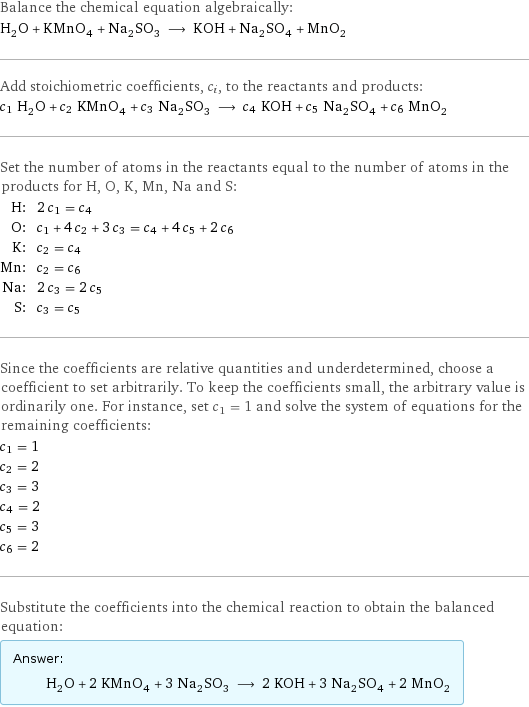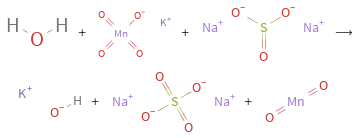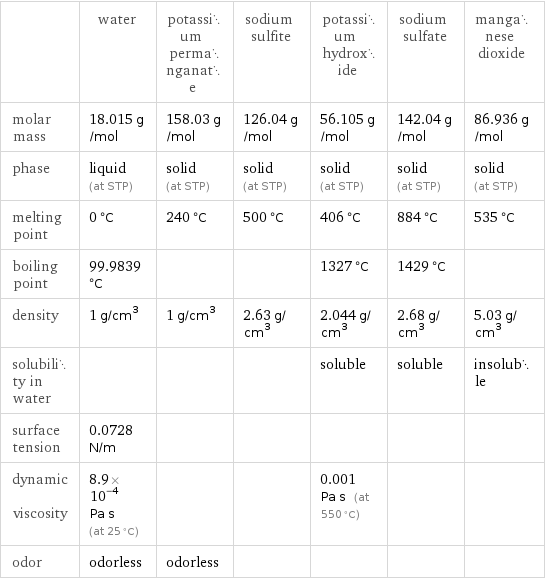Input interpretation

H_2O (water) + KMnO_4 (potassium permanganate) + Na_2SO_3 (sodium sulfite) ⟶ KOH (potassium hydroxide) + Na_2SO_4 (sodium sulfate) + MnO_2 (manganese dioxide)
Balanced equation

Balance the chemical equation algebraically: H_2O + KMnO_4 + Na_2SO_3 ⟶ KOH + Na_2SO_4 + MnO_2 Add stoichiometric coefficients, c_i, to the reactants and products: c_1 H_2O + c_2 KMnO_4 + c_3 Na_2SO_3 ⟶ c_4 KOH + c_5 Na_2SO_4 + c_6 MnO_2 Set the number of atoms in the reactants equal to the number of atoms in the products for H, O, K, Mn, Na and S: H: | 2 c_1 = c_4 O: | c_1 + 4 c_2 + 3 c_3 = c_4 + 4 c_5 + 2 c_6 K: | c_2 = c_4 Mn: | c_2 = c_6 Na: | 2 c_3 = 2 c_5 S: | c_3 = c_5 Since the coefficients are relative quantities and underdetermined, choose a coefficient to set arbitrarily. To keep the coefficients small, the arbitrary value is ordinarily one. For instance, set c_1 = 1 and solve the system of equations for the remaining coefficients: c_1 = 1 c_2 = 2 c_3 = 3 c_4 = 2 c_5 = 3 c_6 = 2 Substitute the coefficients into the chemical reaction to obtain the balanced equation: Answer: | | H_2O + 2 KMnO_4 + 3 Na_2SO_3 ⟶ 2 KOH + 3 Na_2SO_4 + 2 MnO_2
Structures

+ + ⟶ + +
Names

water + potassium permanganate + sodium sulfite ⟶ potassium hydroxide + sodium sulfate + manganese dioxide
Reaction thermodynamics
Gibbs free energy

| water | potassium permanganate | sodium sulfite | potassium hydroxide | sodium sulfate | manganese dioxide molecular free energy | -237.1 kJ/mol | -737.6 kJ/mol | -10125 kJ/mol | -379.4 kJ/mol | -1270 kJ/mol | -465.1 kJ/mol total free energy | -237.1 kJ/mol | -1475 kJ/mol | -30375 kJ/mol | -758.8 kJ/mol | -3811 kJ/mol | -930.2 kJ/mol | G_initial = -32087 kJ/mol | | | G_final = -5500 kJ/mol | | ΔG_rxn^0 | -5500 kJ/mol - -32087 kJ/mol = 26588 kJ/mol (endergonic) | | | | |
Equilibrium constant
![Construct the equilibrium constant, K, expression for: H_2O + KMnO_4 + Na_2SO_3 ⟶ KOH + Na_2SO_4 + MnO_2 Plan: • Balance the chemical equation. • Determine the stoichiometric numbers. • Assemble the activity expression for each chemical species. • Use the activity expressions to build the equilibrium constant expression. Write the balanced chemical equation: H_2O + 2 KMnO_4 + 3 Na_2SO_3 ⟶ 2 KOH + 3 Na_2SO_4 + 2 MnO_2 Assign stoichiometric numbers, ν_i, using the stoichiometric coefficients, c_i, from the balanced chemical equation in the following manner: ν_i = -c_i for reactants and ν_i = c_i for products: chemical species | c_i | ν_i H_2O | 1 | -1 KMnO_4 | 2 | -2 Na_2SO_3 | 3 | -3 KOH | 2 | 2 Na_2SO_4 | 3 | 3 MnO_2 | 2 | 2 Assemble the activity expressions accounting for the state of matter and ν_i: chemical species | c_i | ν_i | activity expression H_2O | 1 | -1 | ([H2O])^(-1) KMnO_4 | 2 | -2 | ([KMnO4])^(-2) Na_2SO_3 | 3 | -3 | ([Na2SO3])^(-3) KOH | 2 | 2 | ([KOH])^2 Na_2SO_4 | 3 | 3 | ([Na2SO4])^3 MnO_2 | 2 | 2 | ([MnO2])^2 The equilibrium constant symbol in the concentration basis is: K_c Mulitply the activity expressions to arrive at the K_c expression: Answer: | | K_c = ([H2O])^(-1) ([KMnO4])^(-2) ([Na2SO3])^(-3) ([KOH])^2 ([Na2SO4])^3 ([MnO2])^2 = (([KOH])^2 ([Na2SO4])^3 ([MnO2])^2)/([H2O] ([KMnO4])^2 ([Na2SO3])^3)](../image_source/cb967ecddb29b0d167ccbf3c1dd6ae91.png)
Construct the equilibrium constant, K, expression for: H_2O + KMnO_4 + Na_2SO_3 ⟶ KOH + Na_2SO_4 + MnO_2 Plan: • Balance the chemical equation. • Determine the stoichiometric numbers. • Assemble the activity expression for each chemical species. • Use the activity expressions to build the equilibrium constant expression. Write the balanced chemical equation: H_2O + 2 KMnO_4 + 3 Na_2SO_3 ⟶ 2 KOH + 3 Na_2SO_4 + 2 MnO_2 Assign stoichiometric numbers, ν_i, using the stoichiometric coefficients, c_i, from the balanced chemical equation in the following manner: ν_i = -c_i for reactants and ν_i = c_i for products: chemical species | c_i | ν_i H_2O | 1 | -1 KMnO_4 | 2 | -2 Na_2SO_3 | 3 | -3 KOH | 2 | 2 Na_2SO_4 | 3 | 3 MnO_2 | 2 | 2 Assemble the activity expressions accounting for the state of matter and ν_i: chemical species | c_i | ν_i | activity expression H_2O | 1 | -1 | ([H2O])^(-1) KMnO_4 | 2 | -2 | ([KMnO4])^(-2) Na_2SO_3 | 3 | -3 | ([Na2SO3])^(-3) KOH | 2 | 2 | ([KOH])^2 Na_2SO_4 | 3 | 3 | ([Na2SO4])^3 MnO_2 | 2 | 2 | ([MnO2])^2 The equilibrium constant symbol in the concentration basis is: K_c Mulitply the activity expressions to arrive at the K_c expression: Answer: | | K_c = ([H2O])^(-1) ([KMnO4])^(-2) ([Na2SO3])^(-3) ([KOH])^2 ([Na2SO4])^3 ([MnO2])^2 = (([KOH])^2 ([Na2SO4])^3 ([MnO2])^2)/([H2O] ([KMnO4])^2 ([Na2SO3])^3)
Rate of reaction
![Construct the rate of reaction expression for: H_2O + KMnO_4 + Na_2SO_3 ⟶ KOH + Na_2SO_4 + MnO_2 Plan: • Balance the chemical equation. • Determine the stoichiometric numbers. • Assemble the rate term for each chemical species. • Write the rate of reaction expression. Write the balanced chemical equation: H_2O + 2 KMnO_4 + 3 Na_2SO_3 ⟶ 2 KOH + 3 Na_2SO_4 + 2 MnO_2 Assign stoichiometric numbers, ν_i, using the stoichiometric coefficients, c_i, from the balanced chemical equation in the following manner: ν_i = -c_i for reactants and ν_i = c_i for products: chemical species | c_i | ν_i H_2O | 1 | -1 KMnO_4 | 2 | -2 Na_2SO_3 | 3 | -3 KOH | 2 | 2 Na_2SO_4 | 3 | 3 MnO_2 | 2 | 2 The rate term for each chemical species, B_i, is 1/ν_i(Δ[B_i])/(Δt) where [B_i] is the amount concentration and t is time: chemical species | c_i | ν_i | rate term H_2O | 1 | -1 | -(Δ[H2O])/(Δt) KMnO_4 | 2 | -2 | -1/2 (Δ[KMnO4])/(Δt) Na_2SO_3 | 3 | -3 | -1/3 (Δ[Na2SO3])/(Δt) KOH | 2 | 2 | 1/2 (Δ[KOH])/(Δt) Na_2SO_4 | 3 | 3 | 1/3 (Δ[Na2SO4])/(Δt) MnO_2 | 2 | 2 | 1/2 (Δ[MnO2])/(Δt) (for infinitesimal rate of change, replace Δ with d) Set the rate terms equal to each other to arrive at the rate expression: Answer: | | rate = -(Δ[H2O])/(Δt) = -1/2 (Δ[KMnO4])/(Δt) = -1/3 (Δ[Na2SO3])/(Δt) = 1/2 (Δ[KOH])/(Δt) = 1/3 (Δ[Na2SO4])/(Δt) = 1/2 (Δ[MnO2])/(Δt) (assuming constant volume and no accumulation of intermediates or side products)](../image_source/9f0c79f9e73be18e158467e99ef5b6a7.png)
Construct the rate of reaction expression for: H_2O + KMnO_4 + Na_2SO_3 ⟶ KOH + Na_2SO_4 + MnO_2 Plan: • Balance the chemical equation. • Determine the stoichiometric numbers. • Assemble the rate term for each chemical species. • Write the rate of reaction expression. Write the balanced chemical equation: H_2O + 2 KMnO_4 + 3 Na_2SO_3 ⟶ 2 KOH + 3 Na_2SO_4 + 2 MnO_2 Assign stoichiometric numbers, ν_i, using the stoichiometric coefficients, c_i, from the balanced chemical equation in the following manner: ν_i = -c_i for reactants and ν_i = c_i for products: chemical species | c_i | ν_i H_2O | 1 | -1 KMnO_4 | 2 | -2 Na_2SO_3 | 3 | -3 KOH | 2 | 2 Na_2SO_4 | 3 | 3 MnO_2 | 2 | 2 The rate term for each chemical species, B_i, is 1/ν_i(Δ[B_i])/(Δt) where [B_i] is the amount concentration and t is time: chemical species | c_i | ν_i | rate term H_2O | 1 | -1 | -(Δ[H2O])/(Δt) KMnO_4 | 2 | -2 | -1/2 (Δ[KMnO4])/(Δt) Na_2SO_3 | 3 | -3 | -1/3 (Δ[Na2SO3])/(Δt) KOH | 2 | 2 | 1/2 (Δ[KOH])/(Δt) Na_2SO_4 | 3 | 3 | 1/3 (Δ[Na2SO4])/(Δt) MnO_2 | 2 | 2 | 1/2 (Δ[MnO2])/(Δt) (for infinitesimal rate of change, replace Δ with d) Set the rate terms equal to each other to arrive at the rate expression: Answer: | | rate = -(Δ[H2O])/(Δt) = -1/2 (Δ[KMnO4])/(Δt) = -1/3 (Δ[Na2SO3])/(Δt) = 1/2 (Δ[KOH])/(Δt) = 1/3 (Δ[Na2SO4])/(Δt) = 1/2 (Δ[MnO2])/(Δt) (assuming constant volume and no accumulation of intermediates or side products)
Chemical names and formulas

| water | potassium permanganate | sodium sulfite | potassium hydroxide | sodium sulfate | manganese dioxide formula | H_2O | KMnO_4 | Na_2SO_3 | KOH | Na_2SO_4 | MnO_2 Hill formula | H_2O | KMnO_4 | Na_2O_3S | HKO | Na_2O_4S | MnO_2 name | water | potassium permanganate | sodium sulfite | potassium hydroxide | sodium sulfate | manganese dioxide IUPAC name | water | potassium permanganate | disodium sulfite | potassium hydroxide | disodium sulfate | dioxomanganese
Substance properties

| water | potassium permanganate | sodium sulfite | potassium hydroxide | sodium sulfate | manganese dioxide molar mass | 18.015 g/mol | 158.03 g/mol | 126.04 g/mol | 56.105 g/mol | 142.04 g/mol | 86.936 g/mol phase | liquid (at STP) | solid (at STP) | solid (at STP) | solid (at STP) | solid (at STP) | solid (at STP) melting point | 0 °C | 240 °C | 500 °C | 406 °C | 884 °C | 535 °C boiling point | 99.9839 °C | | | 1327 °C | 1429 °C | density | 1 g/cm^3 | 1 g/cm^3 | 2.63 g/cm^3 | 2.044 g/cm^3 | 2.68 g/cm^3 | 5.03 g/cm^3 solubility in water | | | | soluble | soluble | insoluble surface tension | 0.0728 N/m | | | | | dynamic viscosity | 8.9×10^-4 Pa s (at 25 °C) | | | 0.001 Pa s (at 550 °C) | | odor | odorless | odorless | | | |
Units
